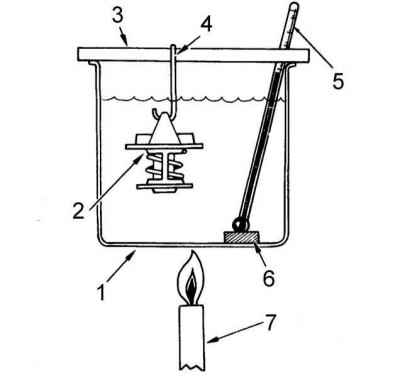Note. You will need a thermometer to perform the test described below.
Removing
1. Disconnect the negative cable from the battery.
2. Empty the cooling system.
3. Disconnect a radiator hose from a thermostat casing.
4. On 4.2L models, disconnect the bypass hose from the thermostat housing (thermostat components of 4.2 l models are shown in the accompanying illustration).

1 - thermostat; 2 - gasket; 3 - casing; 4 - bolts
5. Give bolts of fastening of a casing of the thermostat to the engine.
6. Remove a casing and take the thermostat from the engine.
Functional check
Note. A visual check is often enough to determine if it is functioning properly. For example, a thermostat removed from a cold engine with a fully open valve is no doubt defective and must be replaced.
1. Make sure the thermostat valve is closed and spring-loaded securely when cold.
2. Tie the thermostat to the wire and lower it, together with a reliable thermometer, into a vessel with cold water. Make sure that neither the thermostat nor the thermometer come into contact with the walls and bottom of the vessel (see accompanying illustration).

1 - a vessel filled with water; 2 - thermostat; 3 - transversely laid plank; 4 - wire; 5 - thermometer; 6 - wooden gasket; 7 - heat source
3. Start slowly heating the water in the vessel, watching the thermometer. Record the reading as the thermostat valve begins to open.
4. Continue to heat the water until the valve is fully open, measure the height of the valve disc above the seat. Compare Temperature and Valve Height Measurements with Regulatory Requirements (see tables of sizes and adjustments at the end of the guide). If they are out of range, replace the thermostat.
Installation
Installation is in the reverse order.
1. Make sure that all sealing surfaces are absolutely clean, without any traces of liquid sealant.
2. Place a pad of sealant with a cross section of Ø 2÷3 mm on the sealing surface of the thermostat casing.
3. Make sure the sealant is applied to the inside of the bolt holes.
4. Install the thermostat housing on the engine.
Note. Special gaskets are available for installation under the thermostat housing. The compilers of this Guide, in order to avoid the development of leaks, recommend using such a gasket without fail if the condition of the mating surface of the casing leaves much to be desired.
5. Fill the cooling system with coolant and check for leaks.